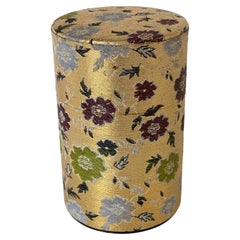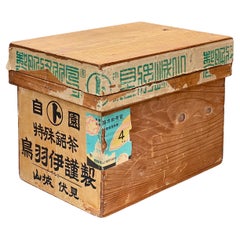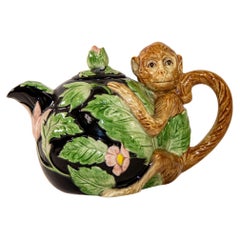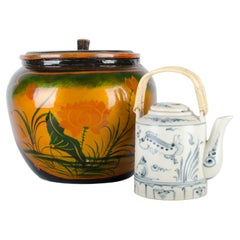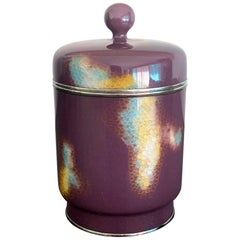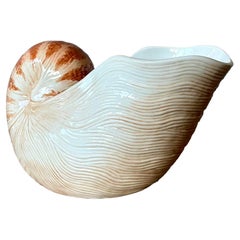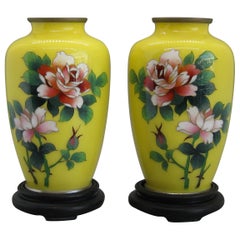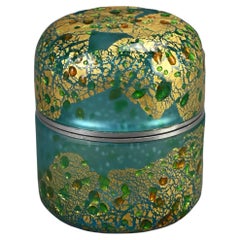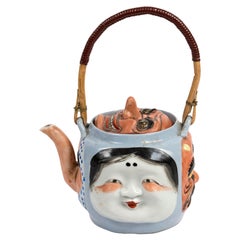Japanese Tea Caddies
to
1
6
6
1
4
1
1
1
1
1
2
2
2
1
1
5
1
14,126
383
295
223
49
Height
to
Width
to
6
6
6
1
1
Place of Origin: Japanese
1960's Japanese Tea Caddy Tin Canister
Located in New York, NY
1960's tin tea caddy covered in traditional Japanese woven gold fabric with floral motif. There are two lids, inner and outer to keep tea leaves fresh.
Category
Mid-20th Century Japonisme Japanese Tea Caddies
Materials
Tin
Vintage Balsa Wood and Tin Lined Tea Box Workshop Prop Decor Storage
Located in Hyattsville, MD
Vintage balsa wood, and tin lined lidded tea box, retaining partial labels.
Category
1950s Mid-Century Modern Vintage Japanese Tea Caddies
Materials
Wood, Paper
$236 Sale Price
20% Off
1980s Vintage Fitz and Floyd Rain Forest Majolica Monkey Ceramic Teapot
By Fitz and Floyd, Royal Doulton
Located in Moreno Valley, CA
Vintage Fitz and Floyd Rain Forest Monkey Majolica ceramic Teapot.
Vintage Majolica Monkey Fitz and Floyd 1980s Rain Forest Teapot.
Designed as ...
Category
Late 20th Century Victorian Japanese Tea Caddies
Materials
Ceramic
Japanese Lacquer Padded Teapot Caddy
Located in Savannah, GA
Antique Japanese hand-painted lacquer teapot caddy.
Interior is padded and fitted for blue and white porcelain teapot.
The teapot stands 4¼ inches tall and features a fish on one si...
Category
Mid-20th Century Modern Japanese Tea Caddies
Materials
Porcelain, Lacquer
Japanese Lacquered Natsume 'Tea Box'
Located in PARIS, FR
Natsume in dark red lacquer, decorated with autumn leaves and cherry blossoms in hiramaki-e and nashiji. Interior in black lacquer.
Maple leaves (Momiji) are celebrated in literatur...
Category
Mid-20th Century Japanese Tea Caddies
Materials
Lacquer
Japanese Cloisonné Covered Jar by Ando Jubei
By Ando Jubei
Located in Atlanta, GA
Japanese cloisonné enamels are known as shippo-yaki and the mid-19th century saw the production of very high quality wares in the early centers Nagoya. One of the most renowned works...
Category
Early 20th Century Japonisme Japanese Tea Caddies
Materials
Metal, Sterling Silver, Enamel
Related Items
Vintage Coastal Fitz and Floyd Nautilus Shell Ceramic Cache Pot
By Fitz and Floyd
Located in West Palm Beach, FL
This delightful vintage ceramic bowl is beautifully sculpted to resemble an open nautilus shell, a classic motif in Coastal and Hollywood Regency decor. The body features subtle, wav...
Category
Late 20th Century Hollywood Regency Japanese Tea Caddies
Materials
Ceramic
Fine Pair of Antique Japanese Cloisonné Enamel Vase Attributed to Ando Jubei
By Ando Jubei
Located in San Diego, CA
Fine pair of antique Japanese cloisonné enamel vases dating from the early 1900s. The both are marked by the artist on the bottom. These are attributed to master artist Ando Jubei. B...
Category
Early 20th Century Japanese Tea Caddies
Materials
Enamel
$520 Sale Price / set
20% Off
H 5.5 in W 3 in D 3 in
Majolica French Ceramic Cow Tureen Caugant
By Michel Caugant
Located in Austin, TX
French Majolica cow tureen circa 1940 signed Caugant.
Category
1940s Rustic Vintage Japanese Tea Caddies
Materials
Ceramic, Faience
Pair Porcelain "Bulldogs with Puppies" by Fitz and Floyd Co., American
By Fitz and Floyd
Located in Incline Village, NV
Charming pair of porcelain white seated Bulldogs holding a pair of puppies each from their mouth in a straw basket with a blue bow around their necks; mounted on a blue base. Conditi...
Category
Late 20th Century Mid-Century Modern Japanese Tea Caddies
Materials
Porcelain
$308 Sale Price
20% Off
H 7 in W 5.13 in D 3.5 in
Japanese Maki-e Lacquer Stack Box Jubako
Located in Atlanta, GA
An antique jubako (stack boxes) with five tiers in an elongated octagon shape circa 19th century (end of Edo or beginning of Meiji period). jubako was traditionally used to store and...
Category
19th Century Japonisme Antique Japanese Tea Caddies
Materials
Wood, Lacquer
Japanese Black Lacquer Jubako Box with Stork Motif
Located in Stamford, CT
A four-tier Japanese Meiji period black lacquer Jubako box with stork and fir tree decoration. Box in four sections with lid.
Category
Late 19th Century Edo Antique Japanese Tea Caddies
Materials
Lacquer
Japanese Rinpa Style Lacquer Box Meiji Period
Located in Atlanta, GA
A black lacquer tebako (hand box) with maki-e decoration and silver trim, circa late 19th century, Meiji period. The surface of the lid features a Rinpa style maki-e paint depicting ...
Category
1890s Japonisme Antique Japanese Tea Caddies
Materials
Wood, Lacquer
Antique Pair Hand Made Wood Hat/Storage Boxes
Located in Douglas Manor, NY
1740 Pair antique hand made cedar hat/storage boxes
large 16x6"
Small 9.5x5"
Category
1920s Vintage Japanese Tea Caddies
Materials
Cedar
19th Century Chinese Export Lacquer Decorated Tea Caddy Box
Located in Atlanta, GA
Chinese for the English market, 19th century.
A fine quality antique Chinese export tea caddy decorated with beautiful gilding surfaces, a hinged lid which opens to reveal a tooled ...
Category
19th Century Chinese Export Antique Japanese Tea Caddies
Materials
Pewter
Vintage Coastal Fitz and Floyd Nautilus Cache Pot
Located in West Palm Beach, FL
This charming vintage ceramic cachepot is meticulously molded and glazed in the shape of a nautilus shell, embodying the sophisticated nautical and coastal aesthetics of the mid-to-l...
Category
Late 20th Century Hollywood Regency Japanese Tea Caddies
Materials
Ceramic
Georgian Harewood Tea Caddy
Located in Northampton, GB
With Tuscan Columns & Fan Inlay.
From our Tea Caddy collection, we are pleased to offer this Georgian Harewood Tea Caddy. The Tea Caddy of octagonal shape with a Harewood veneer ext...
Category
Late 18th Century George III Antique Japanese Tea Caddies
Materials
Boxwood, Harewood
Black and Gold Lacquer Japanese Suzuribako Box
Located in Stamford, CT
19th century Japanese black and gold lacquer Suzuribako box with firefly and plum blossom design.
Category
Late 19th Century Antique Japanese Tea Caddies
Materials
Lacquer
Previously Available Items
Japanese Art Glass Natsume Tea Caddy By Kuniaki Kuroki Heisei Period
Located in Norwich, GB
Japanese art glass Natsume tea caddy by Kuniaki Kuroki (b. 1945). - Heisei Period. Circa 2000.
One of Japan’s leading glass artists and pioneers. Kuniaki Kuroki is the recipient of ...
Category
Early 2000s Modern Japanese Tea Caddies
Materials
Gold Leaf
Japanese Banko Teapot
By Banko
Located in PARIS, FR
Banko polychrome enamelled terracotta teapot, representing on each side masks from the Japanese folklore. Handle in wickerwork.
On the spout, Hyottoko, a comical and childlike character. He is recognizable by the shape of his elongated mouth with two red dots (he blows fire with a bamboo pipe), his white scarf with blue dots around his face and his eyes of different sizes. During local festivals like in Miyazaki, he appears in traditional dengaku dances and plays the role of a clown.
On his left, Okame (also called Uzume or Otafuku), deity of Happiness and Good omen, known to bring good fortune. She is shown smiling with two black dots on her forehead.
To the right of Hyottoko, mask of a hero in kabuki theater. The stage make-up work by the actors is called kumadori. It is characterizd by a white complexion, colors and patterns symbolizing aspects of the actor's personality. The red color symbolizes virtue and power, and characterizes a powerful hero.
On the back side, the demon Oni, with its horns and sharp teeth. He symbolizes greed. During the Setsubun festival, people expel bad luck and invite good luck by throwing beans at it.
Cover representing Tengu with a red face, scary eyes and a long nose. It is a half-god, half-demon being from the Shinto tradition, with the ability to fly. He is reputed to divert humans from their Buddhist faith. According to some traditions, he is the protector of the mountains. The Tengu mask...
Category
Early 20th Century Japanese Tea Caddies
Materials
Ceramic, Bamboo
Japanese Miniature Satsuma Tea Caddy Kinkozan
By Kinkozan
Located in Newark, England
Fine Japanese Kinkozan miniature Natsume (tea caddy) Meiji period. The Caddy of rectangular form with four panelled scenes depicting vast landscapes, foliage, buildings and chickens. The boarders decorated with intricate gilt flowers of scrolling design with matching lid. To the base a four character calligraphy mark black embellished in gold reading...
Category
Late 19th Century Meiji Antique Japanese Tea Caddies
Materials
Earthenware
Japanese Silver Lacquer Tea Caddy 棗 'Natsume' with Autumn Leaves 椛 'Momiji'
Located in Amsterdam, NL
Fantastic dark silver lacquered cylindrical tea caddy (natsume) with a refined continuous silver and gold hiramaki-e (low-relief lacquer design) and takamaki-e (high-relief design) of autumn leaves (momiji). Some leaves accentuated by nashiji (sprinkled gold lacquer). The inner rim lacquered in gold decorated with a few leaves as well.
The interior is lacquered evenly black, with a lovely detail hidden in the lid; a rake is hidden here, ready to be used to clean up all the autumn leaves. The rake is surrounded by silver and gold specks of different shapes.
The circular recess at the bottom is signed by the artist.
Including original signed and sealed wooden tomobako (storage box).
Maki-e, (? ?, literally sparkling painting) is the art of decorating lacquered wood objects...
Category
20th Century Japanese Tea Caddies
Materials
Wood, Lacquer
Japanese Lacquer Insect Natsume Saratani Tomizo
By Saratani Tomizo
Located in Newark, England
Fine Japanese black lacquer natsume by Saratani Tomizõ circa 1970. The lidded tea caddy with rounded edges and flat base with two suzumshi (bell crickets native to Asia) of exceptional detail with long antennae stretching across a large proportional of the box amongst three large foliage branched leaves. The box with a flat raised copper speckled metallic coloured base signed to the underneath. To the interior the box is pitch black in colour with no inside decoration. The original fitted box tied with a single ribbon and signed multiple times throughout. Chinese calligraphy to the wooden box reads ??? Picture of insects/crickets, ??? black, medium sized natsume (tea caddy for keeping powdered tea).
Measurements Natsume 7.2cm High x 6.8cm Wide - Box 9.9cm High 8.5cm Wide
Notes Saratani Tomizo began his career in the 1960s, apprenticing under lacquer artists Saratani Katsuzo, his father, and Suzuki Masaya. He joined the Kyoto lacquer...
Category
Late 20th Century Meiji Japanese Tea Caddies
Materials
Lacquer
Japanese Blue and White Porcelain Tea Caddy
Located in West Palm Beach, FL
Antique Japanese porcelain tea caddy with cover. Hand decorated in a delicate fashion with an underglaze blue color. The jar appears to be hand thr...
Category
1920s Japonisme Vintage Japanese Tea Caddies
Materials
Porcelain
Japanese Meiji Period Keyaki Wood Hibachi with Copper Liner and Drawers
Located in Kastrup, DK
A Japanese keyaki wood (Zelkova) hibachi with copper liner from the Meiji period.
Commonly used for cooking or warming sake or tea.
Features a rectangular keyaki wood frame surroun...
Category
Late 19th Century Meiji Antique Japanese Tea Caddies
Materials
Hardwood
H 15.75 in W 27.56 in D 14.97 in
Japanese Black Lacquered Tea Caddy
Located in Montreal, QC
Japanese black lacquered representing figures entertaining themselves.
Category
1890s Antique Japanese Tea Caddies
Materials
Lacquer
Japan Gold Inlaid Red Lacquered Tea Caddies Pair of Chaire
Located in South Burlington, VT
Japan, a handsome pair of gold inlaid red lacquered tea containers chaire or chaki "Chyrsanthemum & contemporary roundel" motif with various inlays on lid and sides, mi...
Category
20th Century Showa Japanese Tea Caddies
Materials
Gold Leaf
Set of Eight Kitchen Canisters
Located in Pasadena, CA
1920s set of eight kitchen canisters of faces from Japan.
Small: 4" H x 2.75" W x 2.5" D.
Medium: 6.5" H x 5.25" W x 3.25" D.
Large: 7" H x 4.5" W...
Category
1920s Vintage Japanese Tea Caddies
Pair of Japanese Oriental Painted Tea Bins. Circa 1820
Located in Charleston, SC
Pair of Japanese paneled pine and painted Oriental tea bins with parrots , fish, and floral motif. Each bin has a removable lid. 12" diameter top and 11" diam...
Category
19th Century Antique Japanese Tea Caddies
Large Japanese Tea Box
Located in San Francisco, CA
Great looking old tin lined box with hand printed rice paper exterior. This would make an interesting side table.
Category
20th Century Japanese Tea Caddies
Recently Viewed
View AllMore Ways To Browse
Footed Tea Caddy
Tea Caddy Stand
Tea Caddy With Key
Antique Apple Boxes
Antique Fruitwood Tea Caddy
Bombe Tea Caddy
Chinese Pewter Tea Caddy
Fruit Tea Caddy
Monkey Teapot
Tortoiseshell Box 18th Century
Japanese Canister
Pewter Canister
Wooden Canister
Antique Coffee Bean Dispenser
Antique Weaving Machine
Boulle Tea Caddy
Chinese Tea Chest
Repousse Silver Tea Caddy
